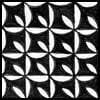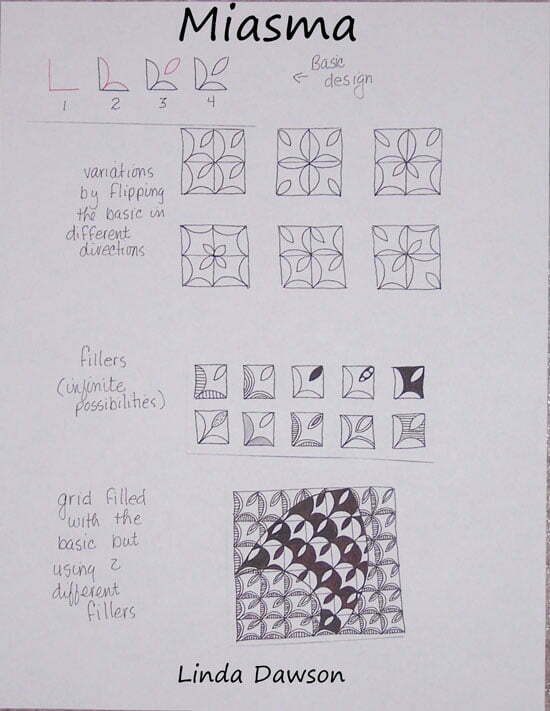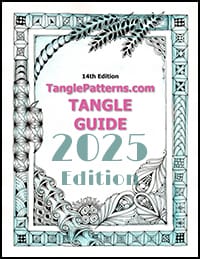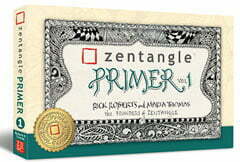 This bold tangle is from Linda Dawson of Kaukauna, Wisconsin, and it’s her first on the site. Linda says she named it “Miasma because it changes shape and mood so easily.”
This bold tangle is from Linda Dawson of Kaukauna, Wisconsin, and it’s her first on the site. Linda says she named it “Miasma because it changes shape and mood so easily.”
Although Miasma looks like it starts with a grid like the official tangle Chillon, Linda’s deconstruction is different and the variations she shares are made possible by “flipping the basic design in different directions” and from there it takes off on its own.
For my example I played with several of Linda’s “flipped” variations but in the end decided to use her basic design with a solid fill. And I turned it around too just to show “there’s no right side up”.
“I have been tangling for about a year and like to develop patterns … I find tangling is a great activity for a newly retired person! … Miasma is amazingly simple, yet the variations are endless.“
Here are Linda’s steps for drawing Miasma, some suggestions for variations based on flipping the design, 10 suggestions for fillers, and Zentangle-inspired example using her basic grid and different fills.
With all these combinations, Miasma can keep you creating in a fog for quite a while.

Image copyright the artist and used with permission, ALL RIGHTS RESERVED. Please feel free to refer to the step outs to recreate this tangle in your Zentangles and ZIAs, or link back to this page. However the artist and TanglePatterns.com reserve all rights to these images and they should not be pinned, reproduced or republished. Thank you for respecting these rights.
Check out the tag lindad for more of Linda’s patterns on TanglePatterns.com.
Related Links
- Looking for tangles by Artist or Type? For details visit the ABOUT > HOW TO FIND TANGLES BY ARTIST OR TYPE page on the top menu bar of any page on the site.
- What is a Zentangle? — if you are new to the Zentangle Method, start here for the fundamentals.
- Zentangle terminology — a glossary of terms used in this art form.
- How to use the site — an excellent free video tutorial showing how to use the site as well as pointing out lots of useful features you might have missed.
- Linda's List of Zentangle-Original Patterns — here is the complete list of original tangles (aka "official tangles") created and introduced by founders Rick Roberts and Maria Thomas, including those not published online. If you are new to the Zentangle Method I highly recommend learning a few of the published Zentangle classics first.
- "A Zentangle has no up or down and is not a picture of something, so you have no worries about whether you can draw a hand, or a duck. You always succeed in creating a Zentangle." Patterns that are drawings of a recognizable naturalistic or actual object, figure, or scene, are not tangles. A pattern is not always a tangle — here's what makes a tangle. TIP: tangles never start with pencil planning.
- Un motif n’est pas toujours un tangle — Qu’est-ce qu’un tangle ?
- Un diseño no es siempre un tangle — ¿Qué es un tangle?
- How to submit your pattern deconstruction to TanglePatterns
- For lots of great FREE tutorials on TanglePatterns, click on the TUTORIALS link in the pink alphabetic menu bar below the tangle images at the top of any page.
- Strings! Have we got STRINGS! Click on the STRINGS link in the pink alphabetic menu bar below the tangle images at the top of any page for 250 different (free) Zentangle-starters. More than enough for any lifetime!
- Never miss a tangle! FREE eMAIL NEWSLETTER - visit the Here's how to SUBSCRIBE button (top of left sidebar on any page) and sign up to get notices delivered free to your inbox.
- If you have questions about the TanglePatterns.com TANGLE GUIDE, visit the BOOK REVIEWS tab on the top menu bar of any page on the site for COMPLETE details!
|
.oOo. |
|
Enhance your Zentangle experience while supporting TanglePatterns: |
|
CURRENT EDITION! TanglePatterns.com TANGLE GUIDE, 2025 Edition |
|
 |
The 14th Edition of the TanglePatterns.com TANGLE GUIDE is an instant-download 117-page interactive digital eBook/PDF containing over 2,000 tangles on the site from May 2010 through December 31, 2024. It's a great resource and a must-have digital tool for using the site. Visit the STORE > E-BOOKS page and help keep TanglePatterns.com going by getting your copy now! |
|
"Linda, Thank you! I was relying on too few and getting stuck after 3 years of daily working with Zentangle. This has inspired me to ‘begin again’ with renewed excitement." ~ Barbara R. |
|
| See the BOOK REVIEWS page for more details on its features and view a sample page. Note: this is a digital product you download immediately when you place your order, nothing will be physically mailed to you. | |
| If you're new to Zentangle® and tangling, my TanglePatterns.com BEGINNER'S GUIDE TO ZENTANGLE is just what you need to get started. Also available en Français and en Español. | |
|
|
|
 |
This is the only Zentangle book you'll ever need: the fabulous Zentangle PRIMER Vol 1. It's your CZT-in-a-book by the founders of Zentangle®. Visit the STORE tab on the top menu bar or click on the image. For more about the content and to read the rave reviews, visit the BOOK REVIEWS tab. |
| Now available in KINDLE format for $9.99. Spanish Edition here. Japanese Edition here. | |
| "Absolutely the best Zentangle Book yet! As an accomplished artist I used to think I did not need instruction on this art form. How wrong I was! My tangling improved by leaps and bounds after reading this book. If you think you have Zentangle down then you need this book more than ever!" ~ Kris H | |
|
|
|
|
.oOo. |
|








I love Miasma and all it’s variants.
General Question: how best to practice making grid based designs. I’m having difficulty establishing an equal base grid. Any suggestions besides using dots arrayed to layout the grid foundation?
You could use an inked dot on one side as a point to aim for. I think the best thing is not to worry about making them perfect. Many of the grid-based patterns looks great with the grid “warped” as I call it, and the hand-drawn look is superior to looking like it was done with a ruler. That’s what Zentangle is all about anyway – no mistakes. If you must aim for perfect, they will get better with practice. Bottom line: relax and go with what you’ve got.
UPDATE: More thoughts on my earlier reply about making grids … a good way to establish the start of your grid is to draw a vertical line in the center of your section and a horizontal line across the center of that line, basically you’re forming a cross in the middle of the section. Then you can eyeball where you want the rest of the lines to go by evenly spacing them on either side of the vertical and horizontal baselines. All the lines can be wavy or straight, whatever you choose. Hope that helps!
Your several suggestions regarding drawing grids would make a hints section. I love using grid based designs based in curved or warped grids. I think they look best when the integrity of the curve or warp are maintained rather evenly even if I want them to warp smaller then larger in the design. Please continue with your suggestions, a great help.
Hi Suzanne.
I have had good luck with grid based patterns by pacticing them on graph paper a few times just before putting them into a piece. The “muscle memory” seems to carry over from graph paper to blank paper or tiles.
Hope this helps!
This is a great new tangle. I love these kind of lines and it is so great that it is shown with so many variations. Thanks for sharing your talent!
– Stephanie
I love these Linda! My daughter and I started working on these as part of her homeschooling art class and are addicted to drawing Tangles. They are so relaxing and really help her stay focused. I would love to teach a class locally.
Hi Rose, here’s more information about teaching Zentangle – https://tanglepatterns.com/zentangles/teaching-zentangle%c2%ae. You might also want to check out the Apprentice program, there’s a link for it on the zentangle.com home page. Glad you and your daughter are finding Zentangle helpful!
Oh, my, I’ll have to start working on a piece today with Miasma in it; I’ve told my local CZT (Kerry Bowes)about how drawing Zentangle patterns is physically helping me get through a very tough and challenging time, including not really having a place to call home. I think Miasma is going to be one of those ‘tangles I can lose myself in.
What a great tangle! So many ways to use it.
Thanks for this! Especially enjoy the variations.